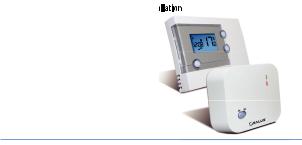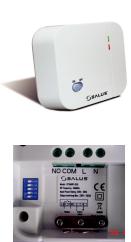Salus RT500RF User Manual

Programmable Room Thermostat
With RF
Instruction Manual
Model No RT500RF

PRODUCT COMPLIANCE
This product complies with the essential requirements of the following EC Directives:
•Electro-Magnetic Compatibility directive 2004/108/EC
•Low Voltage Directive 2006/95/EEC
•EC Marking directive 93/68/EEC
SAFETY INFORMATION
These instructions are applicable to the SALUS Controls model stated on the front cover of this manual only, and must not be used with any other make or model.
These instructions are intended to apply in the United Kingdom only, and should be followed along with any other statutory obligations.
This accessory must be fitted by a Competent person, and installation must comply with the guidance provided in the current editions of BS7671 (IEE Wiring Regulations) and Part ‘P’ of the Building Regulations. Failure to comply with the requirements of these publications could lead to prosecution.
Always isolate the AC Mains supply before opening or removing the unit from the wall or wall box.
When fitting batteries don’t mix old and new batteries together. Do not use rechargable batteries.
Please leave these instructions with the end user where they should be kept in a safe place for future reference.
2RT500RF INSTRUCTION MANUAL

INTRODUCTION
What is a programmable room thermostat?
... an explanation for householders
A programmable room thermostat is both a programmer and a room thermostat. A programmer allows you to set ‘On’ and ‘Off’ time periods to suit your own lifestyle. A room thermostat works by sensing the air temperature, switching on the heating when the air temperature falls below the thermostat setting, and switching it off once this set temperature has been reached.
So, a programmable room thermostat lets you choose what times you want the heating to be on, and what temperature it should reach while it is on. It will allow you to select different temperatures in your home at different times of the day (and days of the week) to meet your particular needs.
Turning a programmable room thermostat to a higher setting will not make the room heat up any faster. How quickly the room heats up depends on the design of the heating system, for example, the size of boiler and radiators.
Neither does the setting affect how quickly the room cools down. Turning a programmable room thermostat to a lower setting will result in the room being controlled at a lower temperature, and saves energy.
The way to set and use your programmable room thermostat is to find the lowest temperature settings that you are comfortable with at the different times you have chosen, and then leave it alone to do its job. The best way to do this is to set low temperatures first, say 18°C, and then turn them up by one degree each day until you are comfortable with the temperatures. You won’t have to adjust the thermostat further. Any adjustments above these settings will waste energy and cost you more money.
If your heating system is a boiler with radiators, there will usually be only one programmable room thermostat to control the whole house. But you can have different temperatures in individual rooms by installing thermostatic radiator valves (TRVs) on individual radiators. If you don’t have TRVs, you should choose a temperature that is reasonable for the whole house. If you do have TRVs, you can choose a slightly higher setting to make sure that even the coldest room is comfortable, then prevent any overheating in other rooms by adjusting the TRVs.
The time on the programmer must be correct. Some types have to be adjusted in spring and autumn at the changes between Greenwich Mean Time and British Summer Time.
RT500RF INSTRUCTION MANUAL |
3 |

You may be able to temporarily adjust the heating programme, for example, ‘Override’, ‘Advance’ or ‘Boost’. These are explained in the manufacturer’s instructions.
Programmable room thermostats need a free flow of air to sense the temperature, so they must not be covered by curtains or blocked by furniture. Nearby electric fires, televisions, wall or table lamps may prevent the thermostat from working properly.
INTRODUCTION
The RT500RF from SALUS Controls is a stylish and accurate 5/2 or 7 day programmable electronic thermostat with a large, easy to read Liquid Crystal Display (LCD). This programmable thermostat has been specifically designed to be used for both Volt Free and AC heating applications. This programmable thermostat can replace most common residential thermostats and is designed to be used with electric, gas or oil heating control systems. Unlike ordinary single unit design thermostats, this is a new type of thermostat separating the operational functions into two units.
The Receiver is used for wiring connections and heat on/off control. The Control Centre provides the user interface and temperature sensing / control. The two units are linked together by a Radio Frequency (RF) signal.
Features
•Volt free switching option
•5/2 or 7 day programming flexibility
• Built-in start up programming for quick
•Frost protection
•Large, easy to read LCD with blue backlight
•Burner on symbol
•Easy to use programming
•User friendly
4RT500RF INSTRUCTION MANUAL

INSTALLATION
Please read the important safety information at the start of this manual before you begin to install the device.
The RT500RF Control Centre is easily installed using the Industry Standard back plate supplied with the unit – this is used purely for mounting purposes, as no wiring is needed for the Control Centre. The back plate can be mounted directly to the wall surface.
The ideal position to locate the RT500RF Control Centre is about 1.5m above floor level. It should be mounted in a location where the thermostat is accessible, reasonably lit and free from extremes of temperature and draughts. Do not mount the thermostat on an outside wall, above a radiator or in a location where it may be subjected to direct sunlight.
To ensure trouble free operation of the Radio Frequency (RF) signal, always ensure that the programmable thermostat is mounted away from any possible sources of interference (such as radios, TV sets, computers, etc.), and is not mounted on or in close proximity to large metal objects. Installing the RT500RF in enclosed areas such as cellars and basements is not recommended.
CONNECTING THE RT500RF RECEIVER
NOTE: All electrical installation work should be carried out by a suitably qualified Electrician or other competent person.
If you are not sure how to install this programmable thermostat consult either with a qualified electrician, heating engineer or your boiler / heating system supplier for advice on how to continue.
RT500RF INSTRUCTION MANUAL |
5 |

The RT500RF Receiver should be mounted in a suitable location that is both accessible for the connection of mains and control wiring, and allows good reception of the RF signal. The Receiver needs a 230V AC mains supply to operate, and this should be fused appropriately (13A max.). The Receiver should be mounted in a location where it will not come into contact with water, moisture or condensation.
The Receiver On/Off switch is accessible from the front face of the Receiver, as shown in this picture:
On the front cover of the Receiver you will see that there is the On/Off switch and two Light Emitting diodes (LEDs). The switch allows you to turn off the Receiver if necessary to prevent it calling for heat. The bottom LED (red) will illuminate when the switch is in the ‘On’ position and the unit is receiving power. The top LED (green) illuminates when the Receiver unit is receiving a heat call transmission from the Control Centre.
The wiring terminals and RF Address Code setting DIP switches are located on the rear of the Receiver, as shown in this picture:
RECEIVER WIRING TERMINALS
Terminal |
Identifier |
Description |
1 |
NO |
Normally Open [N/O] |
2 |
COM |
Linked Live feed (230V AC heating applications only) |
3 |
L |
Live feed (230V AC) |
4 |
N |
Neutral |
|
|
|
6RT500RF INSTRUCTION MANUAL

TYPICAL WIRING INSTALLATIONS
a.230V AC Installation
Notes:
•Receiver unit should have a permanent 230V AC main supply
•Confirm that the Boiler has an external thermostat loop and is configured for 230V switching
•If the boiler has two terminals for the thermostat, remove the link from the boiler
b. 24V Installation
Notes:
•Receiver unit should have a permanent 230V AC main supply
•Confirm that the Boiler has an external thermostat loop and is NOT configured for 230V switching
•If the boiler has two terminals for the thermostat, remove the link from the boiler
RT500RF INSTRUCTION MANUAL |
7 |

CONTROL CENTRE JUMPER SETTINGS
Changes to the jumper settings should only be made by the Engineer carrying out the installation or other qualified person.
The installer should select the jumper positions required if changes need to be made to the factory default settings. These jumpers are found on the rear of the Control Centre.
Jumper |
Function |
Program |
Jumper for 5-2 (factory default setting) or 7 |
|
individual days programming. |
|
|
Span |
Movable jumper for selecting temperature span |
|
of ± 0.5°C (factory default setting) or ± 1.0°C |
1,2,3,4,5 |
Removable jumpers for altering the RF address |
|
code when used in conjunction with the |
|
corresponding DIP switch on the Receiver. |
|
|
NOTE: The Reset button must be pressed after changing jumper positions.
8RT500RF INSTRUCTION MANUAL

RF ADDRESS CODE SETTING
If there is another unit being used nearby, e.g. in the next house or as part of a multiple installation, your Receiver may be fault triggered by the other Control Unit. You can change the RF Address Code to help prevent this problem.
Each Receiver can only respond to RF transmissions from a Control Centre that has the same RF address code setting.
Disconnect any AC power to the Receiver, and remove the batteries from the Control Centre before attempting any adjustment of the RF Address Code switches and jumpers. If you are not sure how to carry out this operation correctly, consult either with a qualified electrician or heating engineer.
To adjust the RF address code of the Receiver, simply push up one or more of the 5 DIP switch levers on the DIP switch bank located on the back of the receiver (the levers are numbered 1 to 5 from bottom to top, as shown in the picture below), and then make a note of the setting of each switch:
RT500RF INSTRUCTION MANUAL |
9 |
